Reflective Essay: Gibbs' Cycle and Patient Care (Mr. X)
VerifiedAdded on 2023/01/13
|8
|2239
|61
Essay
AI Summary
This reflective essay, based on Gibbs' reflective cycle, examines a critical incident in a nursing student's practice involving an elderly patient, Mr. X, in the surgical ICU. The patient, suffering from severe sepsis and multiple comorbidities, underwent a CT scan despite the student's concerns about his unstable condition and the lack of family consultation. The essay details the events leading up to the patient's death, including the challenges of transferring Mr. X, the complications during the scan, and the subsequent ethical dilemmas. The student reflects on their feelings of guilt and inadequacy, evaluating the ethical implications of the care provided, particularly the decision to proceed with the CT scan. The analysis delves into the complexities of sepsis management, ethical principles, and communication within the healthcare team. The essay concludes with an action plan, outlining how the student will advocate for patients and address ethical concerns in future practice to improve patient outcomes.
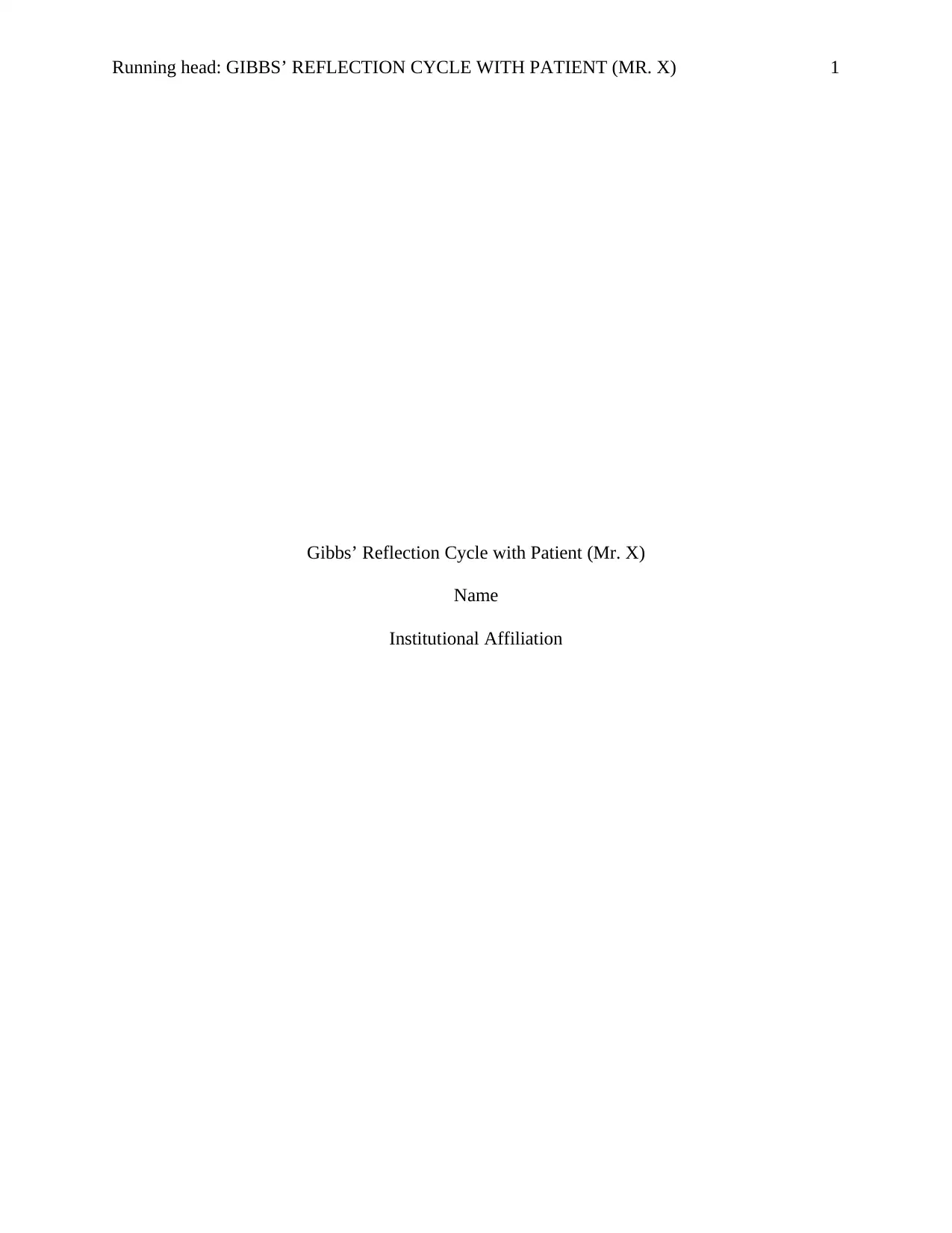
Running head: GIBBS’ REFLECTION CYCLE WITH PATIENT (MR. X) 1
Gibbs’ Reflection Cycle with Patient (Mr. X)
Name
Institutional Affiliation
Gibbs’ Reflection Cycle with Patient (Mr. X)
Name
Institutional Affiliation
Paraphrase This Document
Need a fresh take? Get an instant paraphrase of this document with our AI Paraphraser

GIBBS’ REFLECTION CYCLE WITH PATIENT (MR. X) 2
GIBBS’ REFLECTION CYCLE WITH PATIENT (MR. X)
Description
I cared for an elderly (Mr. X) who was critically ill and was under treatment in surgical
ICU. The patient had been in ICU for 3 weeks after admission with respiratory failure that
required intubation and showing clinical symptoms indicative of sepsis. Mr. X had several other
underlying medical challenges including being morbidly obese. Also, his antibiotic therapy
required high inotropic and ventilator assistance. No definite source of sepsis had been
recognized despite his symptoms. I cared for him on a twelve-hour day shift in morning shift. I
noted that his conditions had worsened substantially over the past two days, with surged inotrope
reliance and deteriorating renal function.
The consultant anesthetist chose to have him undergo a CT scan to identify or even rule
out the abnormal problem as the source sepsis with only a few options for treatment left to try.
Mr. X was assessed by the consultant surgeon who believed in lieu of Mr. X’s co-morbidity, it
would never be suitable to give him any surgery, despite potential positive CT result. Aware that
a CT scan had been undertaken one week previously with no substantial outcome, I voiced my
concerns about the benefits of another CT scan. I recommended that Mr. X’s family (at the very
least) needed to be informed or consulted.
Mr. X’s son had been mentioned as the person to be consulted in the event of no
significant improvement in Mr. X’s conditions. Nonetheless, his son was never informed about
the CT scan that was done. Transferring Mr. X to the radiology department for scanning proved
challenging. He was sedated leading to the demand for surged inotropes because of additional
hypertension triggered by sedation. His large size created a challenge in getting a suitable
transfer trolley to take his weight. I voiced my concerns, highlighting that maybe transfer was
GIBBS’ REFLECTION CYCLE WITH PATIENT (MR. X)
Description
I cared for an elderly (Mr. X) who was critically ill and was under treatment in surgical
ICU. The patient had been in ICU for 3 weeks after admission with respiratory failure that
required intubation and showing clinical symptoms indicative of sepsis. Mr. X had several other
underlying medical challenges including being morbidly obese. Also, his antibiotic therapy
required high inotropic and ventilator assistance. No definite source of sepsis had been
recognized despite his symptoms. I cared for him on a twelve-hour day shift in morning shift. I
noted that his conditions had worsened substantially over the past two days, with surged inotrope
reliance and deteriorating renal function.
The consultant anesthetist chose to have him undergo a CT scan to identify or even rule
out the abnormal problem as the source sepsis with only a few options for treatment left to try.
Mr. X was assessed by the consultant surgeon who believed in lieu of Mr. X’s co-morbidity, it
would never be suitable to give him any surgery, despite potential positive CT result. Aware that
a CT scan had been undertaken one week previously with no substantial outcome, I voiced my
concerns about the benefits of another CT scan. I recommended that Mr. X’s family (at the very
least) needed to be informed or consulted.
Mr. X’s son had been mentioned as the person to be consulted in the event of no
significant improvement in Mr. X’s conditions. Nonetheless, his son was never informed about
the CT scan that was done. Transferring Mr. X to the radiology department for scanning proved
challenging. He was sedated leading to the demand for surged inotropes because of additional
hypertension triggered by sedation. His large size created a challenge in getting a suitable
transfer trolley to take his weight. I voiced my concerns, highlighting that maybe transfer was
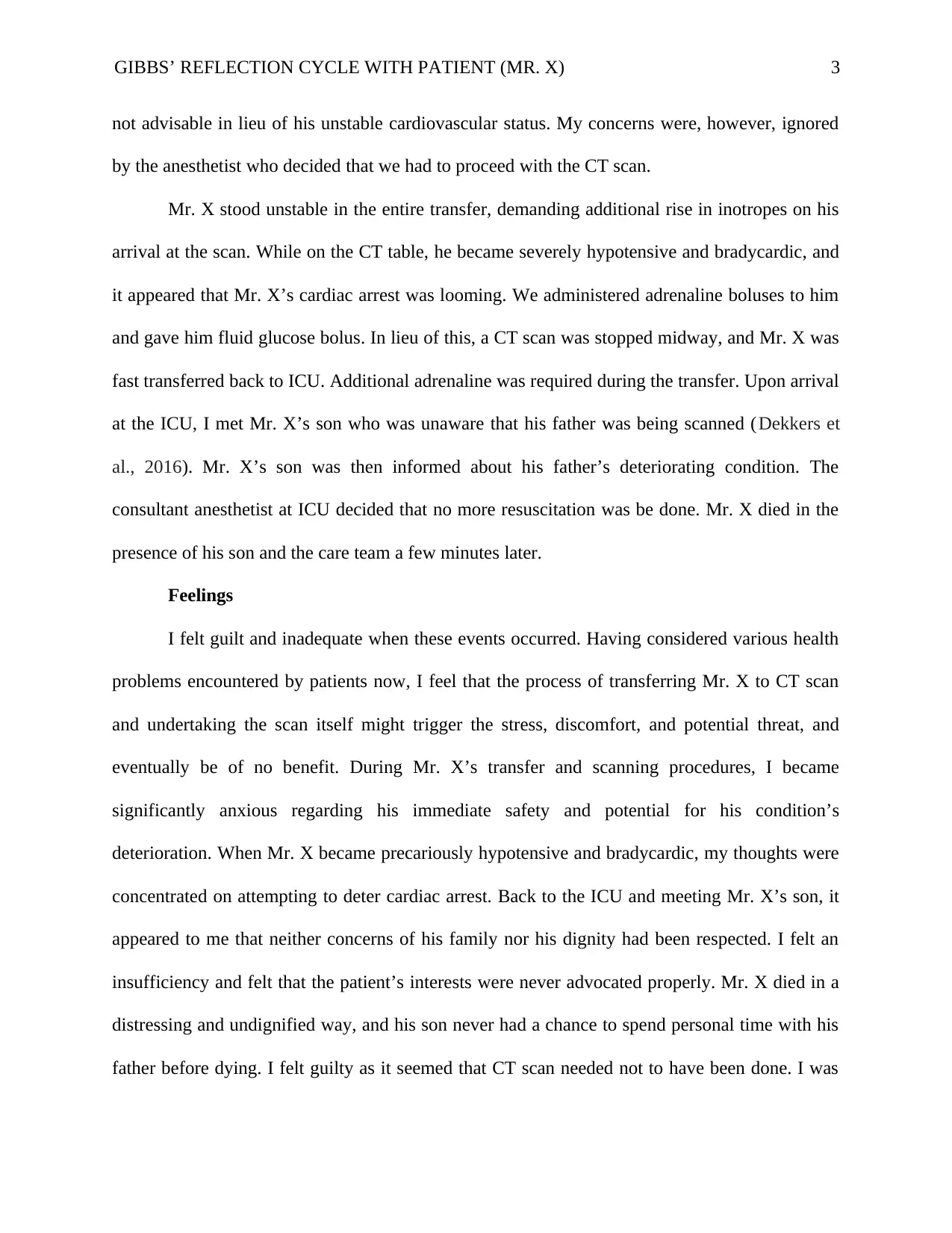
GIBBS’ REFLECTION CYCLE WITH PATIENT (MR. X) 3
not advisable in lieu of his unstable cardiovascular status. My concerns were, however, ignored
by the anesthetist who decided that we had to proceed with the CT scan.
Mr. X stood unstable in the entire transfer, demanding additional rise in inotropes on his
arrival at the scan. While on the CT table, he became severely hypotensive and bradycardic, and
it appeared that Mr. X’s cardiac arrest was looming. We administered adrenaline boluses to him
and gave him fluid glucose bolus. In lieu of this, a CT scan was stopped midway, and Mr. X was
fast transferred back to ICU. Additional adrenaline was required during the transfer. Upon arrival
at the ICU, I met Mr. X’s son who was unaware that his father was being scanned (Dekkers et
al., 2016). Mr. X’s son was then informed about his father’s deteriorating condition. The
consultant anesthetist at ICU decided that no more resuscitation was be done. Mr. X died in the
presence of his son and the care team a few minutes later.
Feelings
I felt guilt and inadequate when these events occurred. Having considered various health
problems encountered by patients now, I feel that the process of transferring Mr. X to CT scan
and undertaking the scan itself might trigger the stress, discomfort, and potential threat, and
eventually be of no benefit. During Mr. X’s transfer and scanning procedures, I became
significantly anxious regarding his immediate safety and potential for his condition’s
deterioration. When Mr. X became precariously hypotensive and bradycardic, my thoughts were
concentrated on attempting to deter cardiac arrest. Back to the ICU and meeting Mr. X’s son, it
appeared to me that neither concerns of his family nor his dignity had been respected. I felt an
insufficiency and felt that the patient’s interests were never advocated properly. Mr. X died in a
distressing and undignified way, and his son never had a chance to spend personal time with his
father before dying. I felt guilty as it seemed that CT scan needed not to have been done. I was
not advisable in lieu of his unstable cardiovascular status. My concerns were, however, ignored
by the anesthetist who decided that we had to proceed with the CT scan.
Mr. X stood unstable in the entire transfer, demanding additional rise in inotropes on his
arrival at the scan. While on the CT table, he became severely hypotensive and bradycardic, and
it appeared that Mr. X’s cardiac arrest was looming. We administered adrenaline boluses to him
and gave him fluid glucose bolus. In lieu of this, a CT scan was stopped midway, and Mr. X was
fast transferred back to ICU. Additional adrenaline was required during the transfer. Upon arrival
at the ICU, I met Mr. X’s son who was unaware that his father was being scanned (Dekkers et
al., 2016). Mr. X’s son was then informed about his father’s deteriorating condition. The
consultant anesthetist at ICU decided that no more resuscitation was be done. Mr. X died in the
presence of his son and the care team a few minutes later.
Feelings
I felt guilt and inadequate when these events occurred. Having considered various health
problems encountered by patients now, I feel that the process of transferring Mr. X to CT scan
and undertaking the scan itself might trigger the stress, discomfort, and potential threat, and
eventually be of no benefit. During Mr. X’s transfer and scanning procedures, I became
significantly anxious regarding his immediate safety and potential for his condition’s
deterioration. When Mr. X became precariously hypotensive and bradycardic, my thoughts were
concentrated on attempting to deter cardiac arrest. Back to the ICU and meeting Mr. X’s son, it
appeared to me that neither concerns of his family nor his dignity had been respected. I felt an
insufficiency and felt that the patient’s interests were never advocated properly. Mr. X died in a
distressing and undignified way, and his son never had a chance to spend personal time with his
father before dying. I felt guilty as it seemed that CT scan needed not to have been done. I was
⊘ This is a preview!⊘
Do you want full access?
Subscribe today to unlock all pages.

Trusted by 1+ million students worldwide
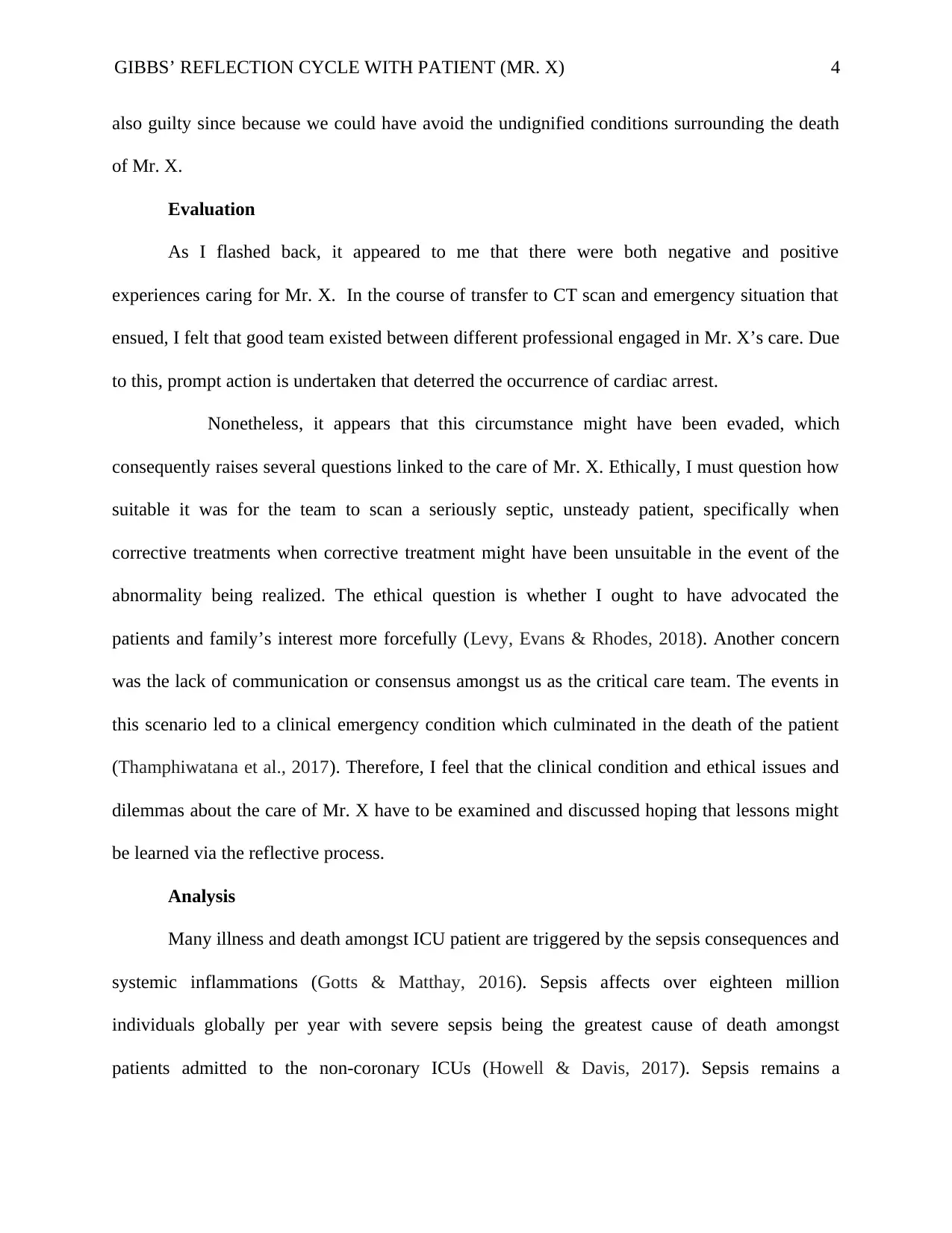
GIBBS’ REFLECTION CYCLE WITH PATIENT (MR. X) 4
also guilty since because we could have avoid the undignified conditions surrounding the death
of Mr. X.
Evaluation
As I flashed back, it appeared to me that there were both negative and positive
experiences caring for Mr. X. In the course of transfer to CT scan and emergency situation that
ensued, I felt that good team existed between different professional engaged in Mr. X’s care. Due
to this, prompt action is undertaken that deterred the occurrence of cardiac arrest.
Nonetheless, it appears that this circumstance might have been evaded, which
consequently raises several questions linked to the care of Mr. X. Ethically, I must question how
suitable it was for the team to scan a seriously septic, unsteady patient, specifically when
corrective treatments when corrective treatment might have been unsuitable in the event of the
abnormality being realized. The ethical question is whether I ought to have advocated the
patients and family’s interest more forcefully (Levy, Evans & Rhodes, 2018). Another concern
was the lack of communication or consensus amongst us as the critical care team. The events in
this scenario led to a clinical emergency condition which culminated in the death of the patient
(Thamphiwatana et al., 2017). Therefore, I feel that the clinical condition and ethical issues and
dilemmas about the care of Mr. X have to be examined and discussed hoping that lessons might
be learned via the reflective process.
Analysis
Many illness and death amongst ICU patient are triggered by the sepsis consequences and
systemic inflammations (Gotts & Matthay, 2016). Sepsis affects over eighteen million
individuals globally per year with severe sepsis being the greatest cause of death amongst
patients admitted to the non-coronary ICUs (Howell & Davis, 2017). Sepsis remains a
also guilty since because we could have avoid the undignified conditions surrounding the death
of Mr. X.
Evaluation
As I flashed back, it appeared to me that there were both negative and positive
experiences caring for Mr. X. In the course of transfer to CT scan and emergency situation that
ensued, I felt that good team existed between different professional engaged in Mr. X’s care. Due
to this, prompt action is undertaken that deterred the occurrence of cardiac arrest.
Nonetheless, it appears that this circumstance might have been evaded, which
consequently raises several questions linked to the care of Mr. X. Ethically, I must question how
suitable it was for the team to scan a seriously septic, unsteady patient, specifically when
corrective treatments when corrective treatment might have been unsuitable in the event of the
abnormality being realized. The ethical question is whether I ought to have advocated the
patients and family’s interest more forcefully (Levy, Evans & Rhodes, 2018). Another concern
was the lack of communication or consensus amongst us as the critical care team. The events in
this scenario led to a clinical emergency condition which culminated in the death of the patient
(Thamphiwatana et al., 2017). Therefore, I feel that the clinical condition and ethical issues and
dilemmas about the care of Mr. X have to be examined and discussed hoping that lessons might
be learned via the reflective process.
Analysis
Many illness and death amongst ICU patient are triggered by the sepsis consequences and
systemic inflammations (Gotts & Matthay, 2016). Sepsis affects over eighteen million
individuals globally per year with severe sepsis being the greatest cause of death amongst
patients admitted to the non-coronary ICUs (Howell & Davis, 2017). Sepsis remains a
Paraphrase This Document
Need a fresh take? Get an instant paraphrase of this document with our AI Paraphraser
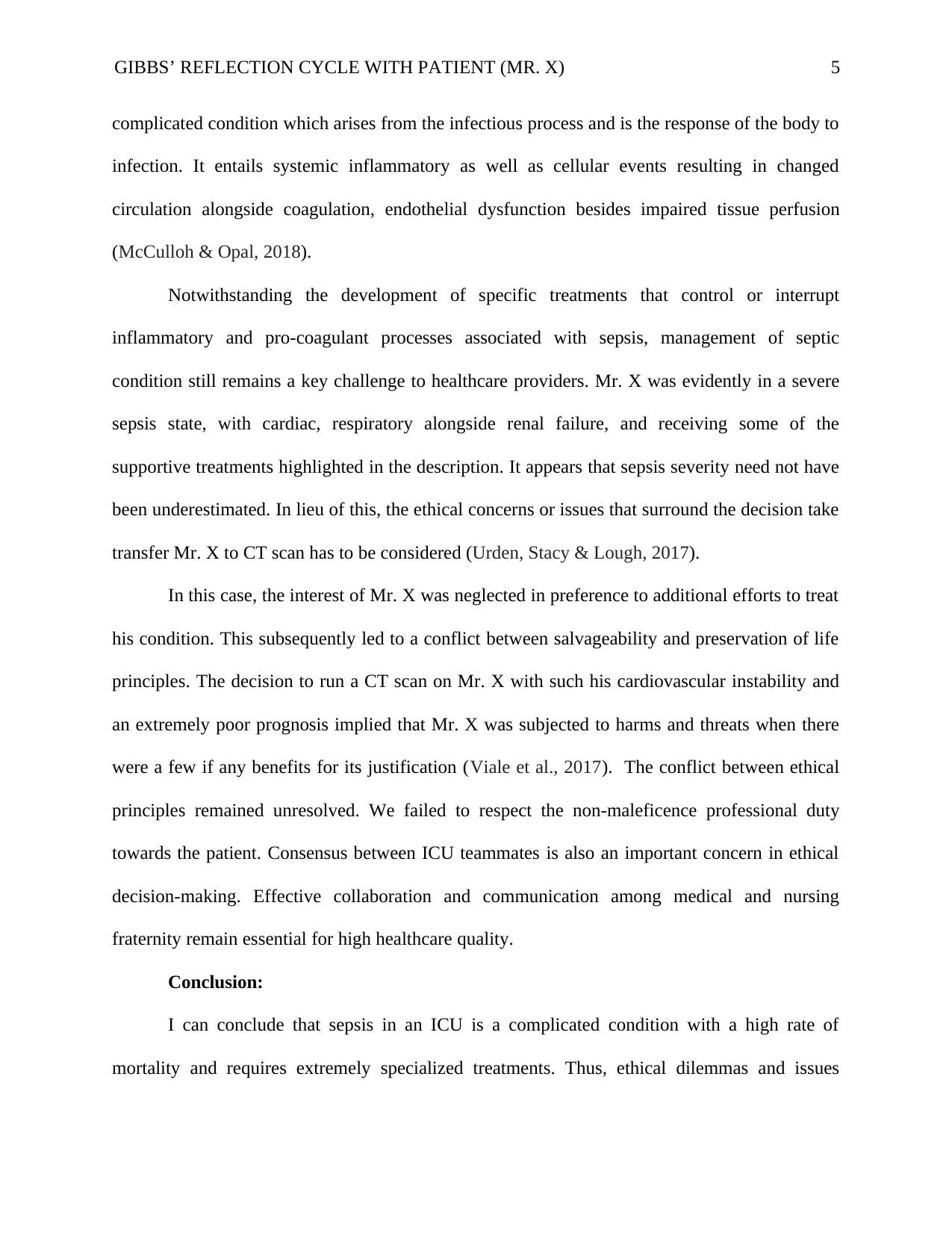
GIBBS’ REFLECTION CYCLE WITH PATIENT (MR. X) 5
complicated condition which arises from the infectious process and is the response of the body to
infection. It entails systemic inflammatory as well as cellular events resulting in changed
circulation alongside coagulation, endothelial dysfunction besides impaired tissue perfusion
(McCulloh & Opal, 2018).
Notwithstanding the development of specific treatments that control or interrupt
inflammatory and pro-coagulant processes associated with sepsis, management of septic
condition still remains a key challenge to healthcare providers. Mr. X was evidently in a severe
sepsis state, with cardiac, respiratory alongside renal failure, and receiving some of the
supportive treatments highlighted in the description. It appears that sepsis severity need not have
been underestimated. In lieu of this, the ethical concerns or issues that surround the decision take
transfer Mr. X to CT scan has to be considered (Urden, Stacy & Lough, 2017).
In this case, the interest of Mr. X was neglected in preference to additional efforts to treat
his condition. This subsequently led to a conflict between salvageability and preservation of life
principles. The decision to run a CT scan on Mr. X with such his cardiovascular instability and
an extremely poor prognosis implied that Mr. X was subjected to harms and threats when there
were a few if any benefits for its justification (Viale et al., 2017). The conflict between ethical
principles remained unresolved. We failed to respect the non-maleficence professional duty
towards the patient. Consensus between ICU teammates is also an important concern in ethical
decision-making. Effective collaboration and communication among medical and nursing
fraternity remain essential for high healthcare quality.
Conclusion:
I can conclude that sepsis in an ICU is a complicated condition with a high rate of
mortality and requires extremely specialized treatments. Thus, ethical dilemmas and issues
complicated condition which arises from the infectious process and is the response of the body to
infection. It entails systemic inflammatory as well as cellular events resulting in changed
circulation alongside coagulation, endothelial dysfunction besides impaired tissue perfusion
(McCulloh & Opal, 2018).
Notwithstanding the development of specific treatments that control or interrupt
inflammatory and pro-coagulant processes associated with sepsis, management of septic
condition still remains a key challenge to healthcare providers. Mr. X was evidently in a severe
sepsis state, with cardiac, respiratory alongside renal failure, and receiving some of the
supportive treatments highlighted in the description. It appears that sepsis severity need not have
been underestimated. In lieu of this, the ethical concerns or issues that surround the decision take
transfer Mr. X to CT scan has to be considered (Urden, Stacy & Lough, 2017).
In this case, the interest of Mr. X was neglected in preference to additional efforts to treat
his condition. This subsequently led to a conflict between salvageability and preservation of life
principles. The decision to run a CT scan on Mr. X with such his cardiovascular instability and
an extremely poor prognosis implied that Mr. X was subjected to harms and threats when there
were a few if any benefits for its justification (Viale et al., 2017). The conflict between ethical
principles remained unresolved. We failed to respect the non-maleficence professional duty
towards the patient. Consensus between ICU teammates is also an important concern in ethical
decision-making. Effective collaboration and communication among medical and nursing
fraternity remain essential for high healthcare quality.
Conclusion:
I can conclude that sepsis in an ICU is a complicated condition with a high rate of
mortality and requires extremely specialized treatments. Thus, ethical dilemmas and issues
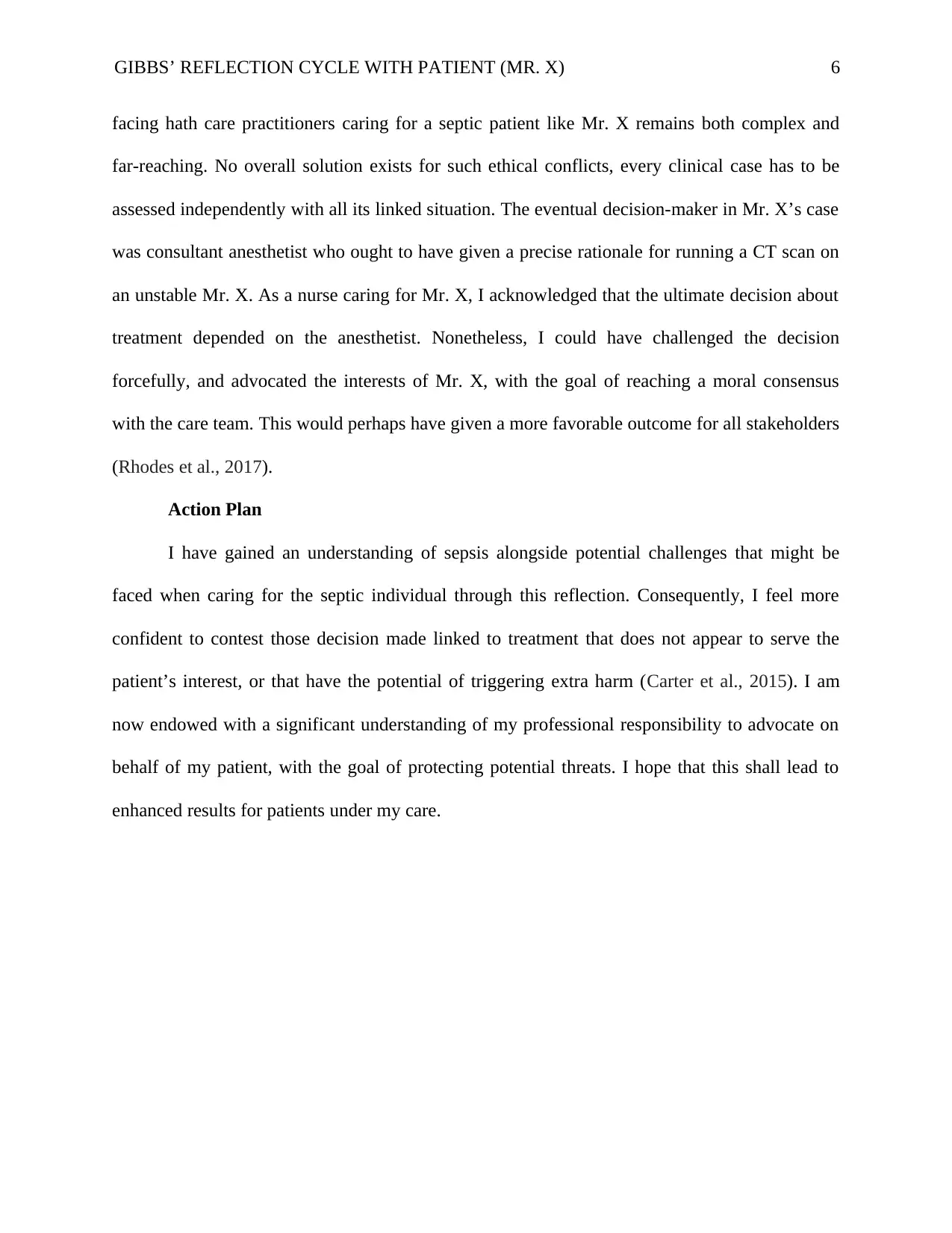
GIBBS’ REFLECTION CYCLE WITH PATIENT (MR. X) 6
facing hath care practitioners caring for a septic patient like Mr. X remains both complex and
far-reaching. No overall solution exists for such ethical conflicts, every clinical case has to be
assessed independently with all its linked situation. The eventual decision-maker in Mr. X’s case
was consultant anesthetist who ought to have given a precise rationale for running a CT scan on
an unstable Mr. X. As a nurse caring for Mr. X, I acknowledged that the ultimate decision about
treatment depended on the anesthetist. Nonetheless, I could have challenged the decision
forcefully, and advocated the interests of Mr. X, with the goal of reaching a moral consensus
with the care team. This would perhaps have given a more favorable outcome for all stakeholders
(Rhodes et al., 2017).
Action Plan
I have gained an understanding of sepsis alongside potential challenges that might be
faced when caring for the septic individual through this reflection. Consequently, I feel more
confident to contest those decision made linked to treatment that does not appear to serve the
patient’s interest, or that have the potential of triggering extra harm (Carter et al., 2015). I am
now endowed with a significant understanding of my professional responsibility to advocate on
behalf of my patient, with the goal of protecting potential threats. I hope that this shall lead to
enhanced results for patients under my care.
facing hath care practitioners caring for a septic patient like Mr. X remains both complex and
far-reaching. No overall solution exists for such ethical conflicts, every clinical case has to be
assessed independently with all its linked situation. The eventual decision-maker in Mr. X’s case
was consultant anesthetist who ought to have given a precise rationale for running a CT scan on
an unstable Mr. X. As a nurse caring for Mr. X, I acknowledged that the ultimate decision about
treatment depended on the anesthetist. Nonetheless, I could have challenged the decision
forcefully, and advocated the interests of Mr. X, with the goal of reaching a moral consensus
with the care team. This would perhaps have given a more favorable outcome for all stakeholders
(Rhodes et al., 2017).
Action Plan
I have gained an understanding of sepsis alongside potential challenges that might be
faced when caring for the septic individual through this reflection. Consequently, I feel more
confident to contest those decision made linked to treatment that does not appear to serve the
patient’s interest, or that have the potential of triggering extra harm (Carter et al., 2015). I am
now endowed with a significant understanding of my professional responsibility to advocate on
behalf of my patient, with the goal of protecting potential threats. I hope that this shall lead to
enhanced results for patients under my care.
⊘ This is a preview!⊘
Do you want full access?
Subscribe today to unlock all pages.

Trusted by 1+ million students worldwide
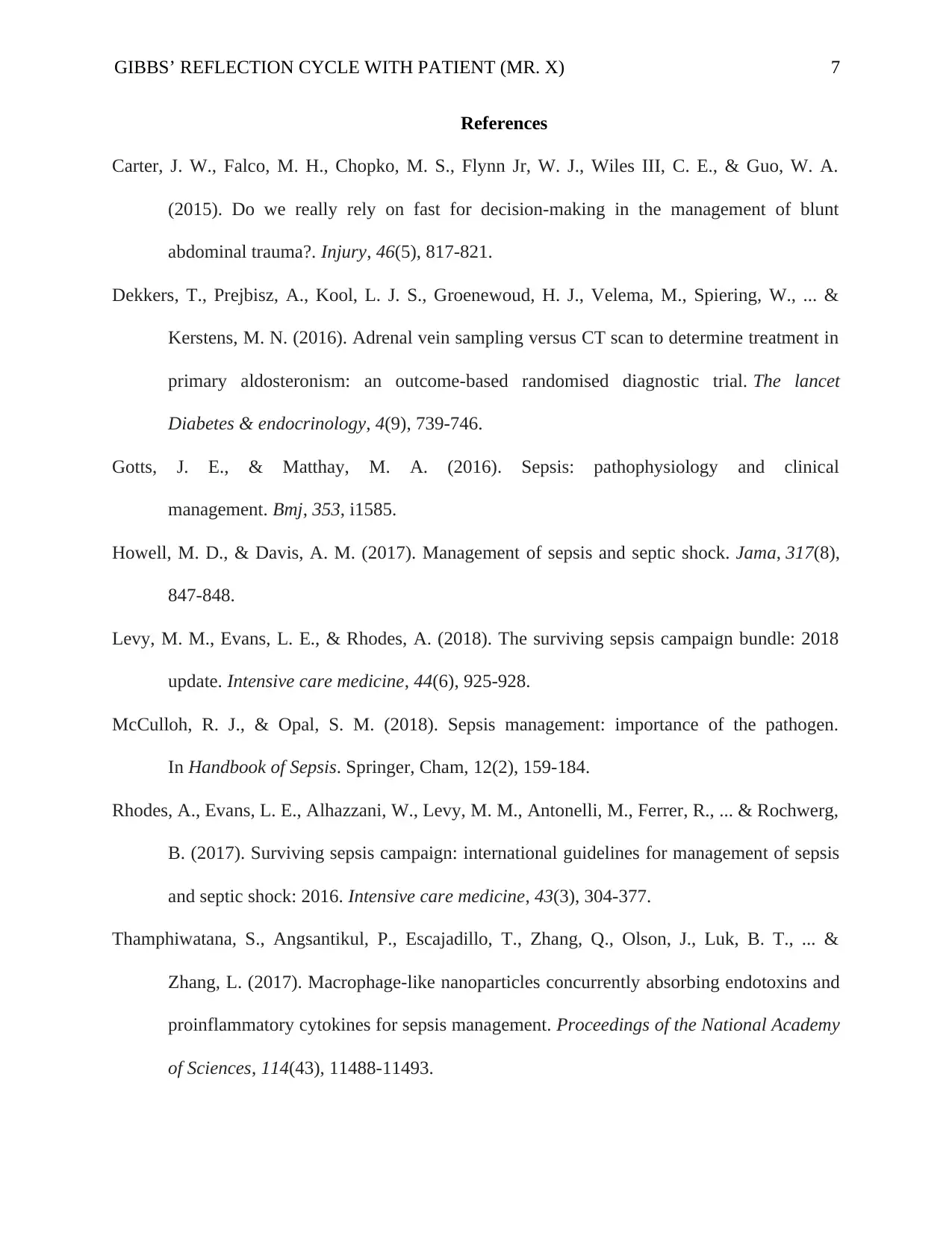
GIBBS’ REFLECTION CYCLE WITH PATIENT (MR. X) 7
References
Carter, J. W., Falco, M. H., Chopko, M. S., Flynn Jr, W. J., Wiles III, C. E., & Guo, W. A.
(2015). Do we really rely on fast for decision-making in the management of blunt
abdominal trauma?. Injury, 46(5), 817-821.
Dekkers, T., Prejbisz, A., Kool, L. J. S., Groenewoud, H. J., Velema, M., Spiering, W., ... &
Kerstens, M. N. (2016). Adrenal vein sampling versus CT scan to determine treatment in
primary aldosteronism: an outcome-based randomised diagnostic trial. The lancet
Diabetes & endocrinology, 4(9), 739-746.
Gotts, J. E., & Matthay, M. A. (2016). Sepsis: pathophysiology and clinical
management. Bmj, 353, i1585.
Howell, M. D., & Davis, A. M. (2017). Management of sepsis and septic shock. Jama, 317(8),
847-848.
Levy, M. M., Evans, L. E., & Rhodes, A. (2018). The surviving sepsis campaign bundle: 2018
update. Intensive care medicine, 44(6), 925-928.
McCulloh, R. J., & Opal, S. M. (2018). Sepsis management: importance of the pathogen.
In Handbook of Sepsis. Springer, Cham, 12(2), 159-184.
Rhodes, A., Evans, L. E., Alhazzani, W., Levy, M. M., Antonelli, M., Ferrer, R., ... & Rochwerg,
B. (2017). Surviving sepsis campaign: international guidelines for management of sepsis
and septic shock: 2016. Intensive care medicine, 43(3), 304-377.
Thamphiwatana, S., Angsantikul, P., Escajadillo, T., Zhang, Q., Olson, J., Luk, B. T., ... &
Zhang, L. (2017). Macrophage-like nanoparticles concurrently absorbing endotoxins and
proinflammatory cytokines for sepsis management. Proceedings of the National Academy
of Sciences, 114(43), 11488-11493.
References
Carter, J. W., Falco, M. H., Chopko, M. S., Flynn Jr, W. J., Wiles III, C. E., & Guo, W. A.
(2015). Do we really rely on fast for decision-making in the management of blunt
abdominal trauma?. Injury, 46(5), 817-821.
Dekkers, T., Prejbisz, A., Kool, L. J. S., Groenewoud, H. J., Velema, M., Spiering, W., ... &
Kerstens, M. N. (2016). Adrenal vein sampling versus CT scan to determine treatment in
primary aldosteronism: an outcome-based randomised diagnostic trial. The lancet
Diabetes & endocrinology, 4(9), 739-746.
Gotts, J. E., & Matthay, M. A. (2016). Sepsis: pathophysiology and clinical
management. Bmj, 353, i1585.
Howell, M. D., & Davis, A. M. (2017). Management of sepsis and septic shock. Jama, 317(8),
847-848.
Levy, M. M., Evans, L. E., & Rhodes, A. (2018). The surviving sepsis campaign bundle: 2018
update. Intensive care medicine, 44(6), 925-928.
McCulloh, R. J., & Opal, S. M. (2018). Sepsis management: importance of the pathogen.
In Handbook of Sepsis. Springer, Cham, 12(2), 159-184.
Rhodes, A., Evans, L. E., Alhazzani, W., Levy, M. M., Antonelli, M., Ferrer, R., ... & Rochwerg,
B. (2017). Surviving sepsis campaign: international guidelines for management of sepsis
and septic shock: 2016. Intensive care medicine, 43(3), 304-377.
Thamphiwatana, S., Angsantikul, P., Escajadillo, T., Zhang, Q., Olson, J., Luk, B. T., ... &
Zhang, L. (2017). Macrophage-like nanoparticles concurrently absorbing endotoxins and
proinflammatory cytokines for sepsis management. Proceedings of the National Academy
of Sciences, 114(43), 11488-11493.
Paraphrase This Document
Need a fresh take? Get an instant paraphrase of this document with our AI Paraphraser
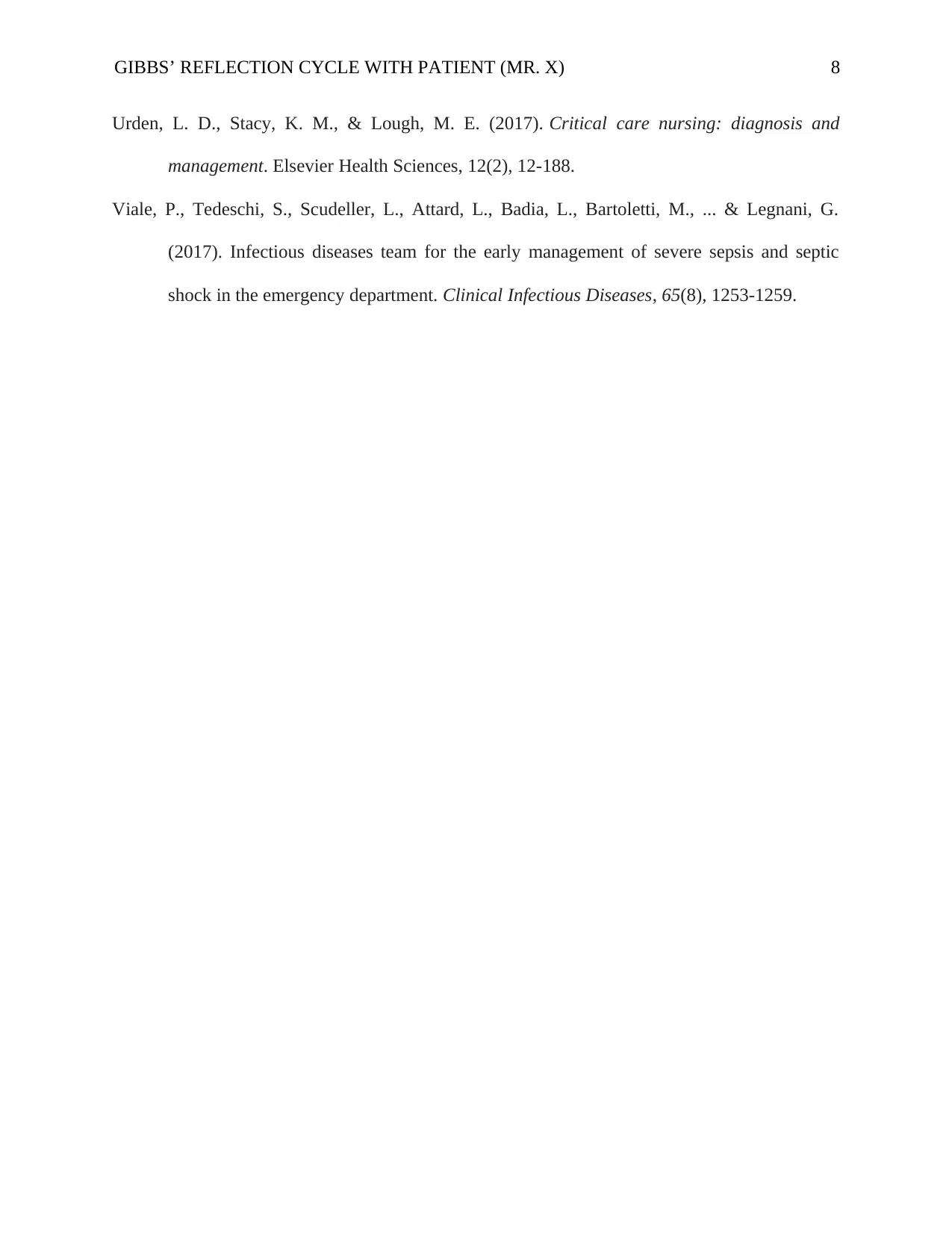
GIBBS’ REFLECTION CYCLE WITH PATIENT (MR. X) 8
Urden, L. D., Stacy, K. M., & Lough, M. E. (2017). Critical care nursing: diagnosis and
management. Elsevier Health Sciences, 12(2), 12-188.
Viale, P., Tedeschi, S., Scudeller, L., Attard, L., Badia, L., Bartoletti, M., ... & Legnani, G.
(2017). Infectious diseases team for the early management of severe sepsis and septic
shock in the emergency department. Clinical Infectious Diseases, 65(8), 1253-1259.
Urden, L. D., Stacy, K. M., & Lough, M. E. (2017). Critical care nursing: diagnosis and
management. Elsevier Health Sciences, 12(2), 12-188.
Viale, P., Tedeschi, S., Scudeller, L., Attard, L., Badia, L., Bartoletti, M., ... & Legnani, G.
(2017). Infectious diseases team for the early management of severe sepsis and septic
shock in the emergency department. Clinical Infectious Diseases, 65(8), 1253-1259.
1 out of 8
Your All-in-One AI-Powered Toolkit for Academic Success.
+13062052269
info@desklib.com
Available 24*7 on WhatsApp / Email
![[object Object]](/_next/static/media/star-bottom.7253800d.svg)
Unlock your academic potential
Copyright © 2020–2025 A2Z Services. All Rights Reserved. Developed and managed by ZUCOL.